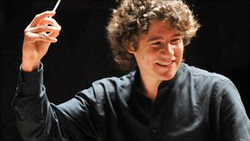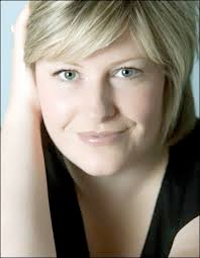by Daniel Hathaway

British guest conductor Robin Ticciati opened the concert on a dramatic note with Hosokawa’s Meditation, written in 2011-2012. Inspired by Gagaku, the slow-flowing imperial court music of Japan, Hosokawa created a gripping, ritualistic lament punctuated by keening violins and penetrating taiko-like wallops from the bass drum. Sad solos by alto flute and English horn ensued, then the full orchestra swelled and raged like the unforgiving sea before skitterings from the strings ultimately vanished into the silence of mourning.
Robin Ticciati and Scottish mezzo-soprano Karen Cargill recorded Berlioz’s Summer Nights less than two years ago, and they had obviously worked out all its details for that occasion. Their live performance on Thursday was special for its coloristic subtleties, its searching delivery of Théophile Gautier’s verse, and its expressive attention to dynamics.
Karen Cargill has an extraordinary voice — rich and hefty when it needs to be, but capable of a wide spectrum of sounds from top to bottom of her range. Her beguiling stage presence drew the listener deeply into Gautier’s special poetical world. But unusually for a singer, her contributions to Berlioz’s finely-constructed musical textures were more like that of an instrumentalist within the orchestra than a soloist singing above and in front of them.
Pacing the work with seemingly all the time in the world to spend, conductor and soloist made special moments out of the hushed phrases in “Le Spectre de la rose” and the dark, low lines of “Sur les lagunes.” A lovely, differently inflected reprise of the refrain graced the end of “Absence,” and “Au Cimetière” was deliciously haunting. “L’île inconnu” ended the set with soloist and orchestra singing and playing full out, though the poetical lines are richly ironic:
“Take me,” said the girl,
“To those faithful shores
Where one is always in love.”
“Such shores, my dear,
Scarcely exist
In the land of love.”
Had the audience been larger, the ovation for Karen Cargill would surely have been tremendous on Thursday evening. The lack of such a critical mass may have made the reaction seem lukewarm, but in fact it was warm, ardent and clearly unanimous. She needs to make a second, third and fourth visit to Cleveland!
Schumann’s rather oddly-structured five-movement symphony — inspired by a visit to Cologne Cathedral, which is majestically situated on the banks of the Rhine — brought the evening to its conclusion in a wash of rich sound. After Ticciati conjured up the great river with supple surges from the strings, the horn section made the first of its many stunning contributions to the sonic glory of the performance. Filling in the “tenor” range of the orchestra, they gave a golden oomph to the ensemble’s tone in tuttis and partnered lyrically with violas and cellos in melodic sections. The rest of the brass held back, letting the horns color their collective tone without overpowering them.
Ticciati was a kinetic presence in the “Rhenish,” conducting with sweeping gestures when not punching up important accents. Channeling Schumann’s exuberance, he brought the joyful finale to a rollicking conclusion. He should become a regular visitor to Cleveland too.
Published on ClevelandClassical.com October 31, 2014.
Click here for a printable copy of this article




